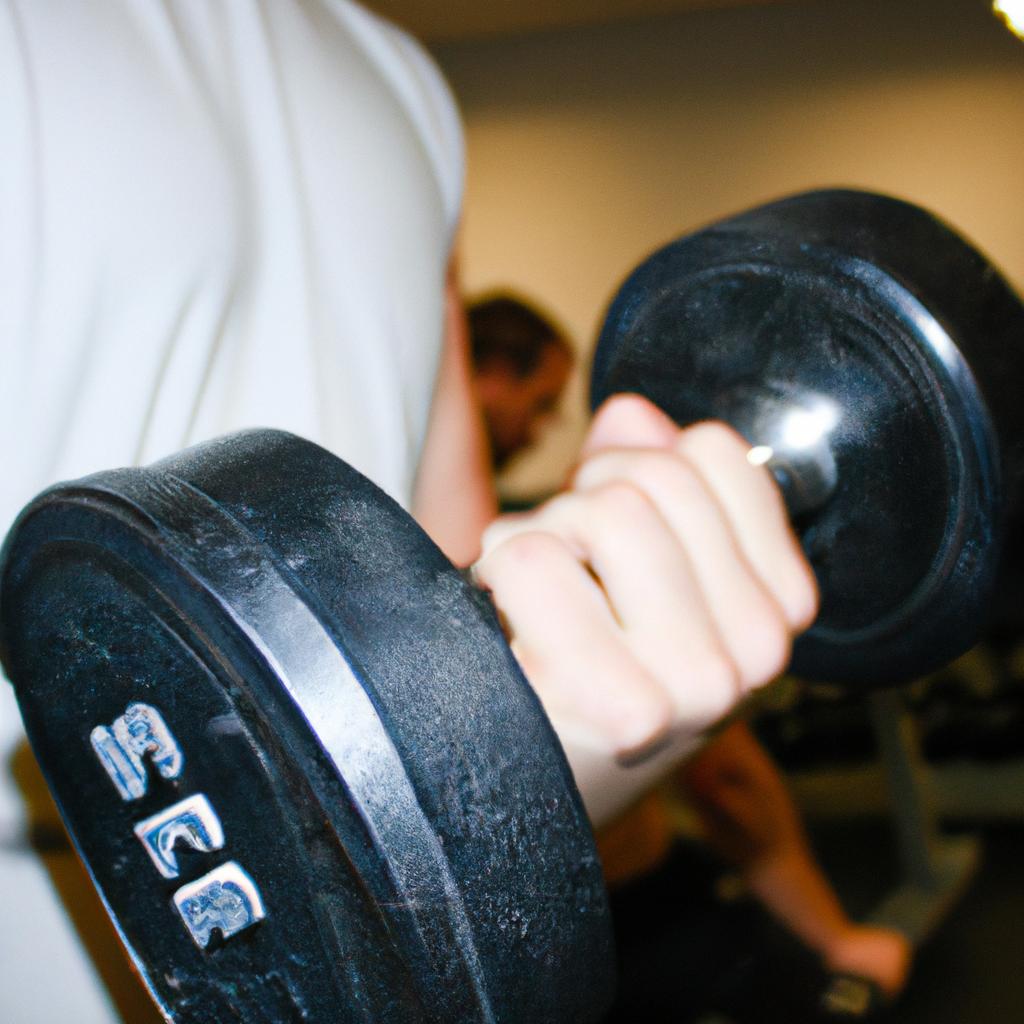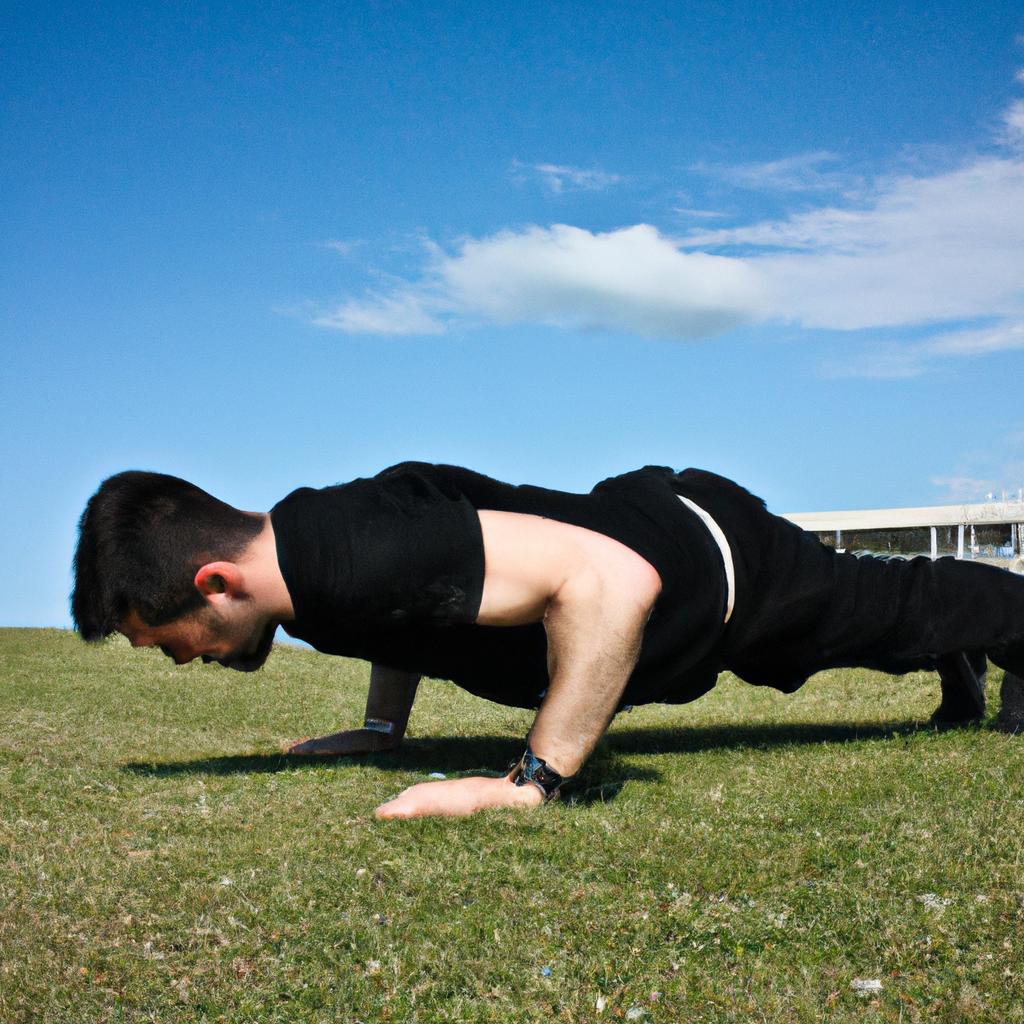In recent years, functional training has gained significant popularity in fitness studios as an effective approach to strength training. This method focuses on improving overall body functionality and performance by engaging multiple muscle groups simultaneously through dynamic movements. For instance, imagine a scenario where an individual wants to improve their ability to perform daily activities such as lifting heavy objects or climbing stairs without feeling fatigued. Functional training would provide them with the tools necessary to achieve these goals by targeting specific muscles that are involved in these actions.
Functional training differs from traditional strength training methods due to its emphasis on real-life movements rather than isolated exercises that target one muscle group at a time. By incorporating full-body exercises that mimic everyday activities, individuals can develop greater stability, mobility, and coordination. Furthermore, this type of training also enhances core strength, which is crucial for maintaining proper posture and preventing injuries during physical activities.
As we delve deeper into the world of functional training within fitness studios, it becomes evident that adopting this approach offers numerous benefits beyond mere aesthetics. The integration of functional exercises not only improves muscular strength but also aids in developing balance and flexibility – essential components for overall physical well-being. Through exploring various techniques used in functional training programs, this article aims to shed light on how fitness enthusiasts can optimize their fitness journey and maximize their overall performance.
One technique commonly used in functional training is resistance training, which involves using external weights or resistance bands to challenge the muscles. This can be done through exercises such as squats, lunges, push-ups, and rows. By progressively increasing the resistance over time, individuals can build strength and endurance in a functional manner.
Another key component of functional training is stability and balance exercises. These exercises often involve engaging the core muscles while performing movements that require maintaining balance, such as single-leg deadlifts or standing on an unstable surface like a Bosu ball. By improving stability and balance, individuals can enhance their proprioception (awareness of body position) and reduce the risk of falls or injuries during daily activities.
Flexibility is also crucial in functional training as it allows for greater range of motion in joints and muscles. Incorporating dynamic stretching exercises into a workout routine can help improve flexibility while also preparing the body for more intense movements. Exercises like walking lunges with a twist or inchworms are great examples of dynamic stretches that target multiple muscle groups simultaneously.
Additionally, functional training often includes plyometric exercises to enhance power and explosiveness. Plyometrics involve rapid muscle contractions followed by explosive movements, such as box jumps or medicine ball throws. These exercises not only develop muscular power but also improve coordination and reaction time – important factors for athletic performance.
To optimize their fitness journey through functional training, individuals should consider working with a qualified fitness professional who specializes in this approach. They can design personalized programs based on specific goals and individual needs while ensuring proper form and technique to prevent injuries.
In conclusion, incorporating functional training into a fitness routine offers numerous benefits beyond solely focusing on aesthetics. By targeting multiple muscle groups simultaneously through real-life movements, individuals can improve overall functionality, stability, mobility, coordination, core strength, balance, flexibility, power, and more. Whether aiming to excel in athletic performance or simply wanting to enhance everyday activities, functional training provides a holistic approach that can optimize physical well-being and maximize overall performance.
Benefits of Functional Training
Functional training has gained popularity in fitness studios due to its effectiveness in improving overall physical performance and functional abilities. By incorporating exercises that mimic daily movements, functional training helps individuals develop strength, stability, flexibility, and endurance needed for daily activities and sports performance.
A case study involving a sedentary office worker highlights the transformative benefits of functional training. Prior to starting a functional training program, this individual struggled with basic tasks such as carrying groceries or climbing stairs without feeling fatigued. However, after several months of consistent functional training sessions, their overall strength and endurance significantly improved. They could now effortlessly perform these activities while experiencing less fatigue.
One key benefit of functional training is its ability to enhance movement efficiency through increased neuromuscular coordination. This type of training involves engaging multiple muscle groups simultaneously rather than isolating specific muscles. As a result, individuals become more proficient at coordinating movements between different muscle groups and joints. This improved coordination leads to smoother and more efficient body mechanics during daily activities.
Moreover, functional training focuses on developing core strength and stability – essential components for maintaining proper posture and preventing injuries. A strong core not only enhances balance but also supports all other movements performed by the body. Additionally, it improves spinal alignment and reduces the risk of lower back pain – a common issue among individuals who lead predominantly sedentary lifestyles.
- Increased confidence in performing everyday tasks
- Enhanced athletic performance across various sports
- Decreased risk of injury during physical activity
- Improved quality of life through enhanced mobility
In addition to these advantages, functional training offers numerous other benefits that can be represented in an emotionally impactful 3-column table:
| Benefit | Description | Emotional Response |
|---|---|---|
| Physical Strength | Develops muscular power & improves overall strength | Feeling empowered |
| Flexibility | Enhances range of motion & joint flexibility | Increased freedom |
| Endurance | Builds stamina & improves cardiovascular fitness | Energized and resilient |
| Injury Prevention | Strengthens muscles, joints, and connective tissues | Peace of mind |
In conclusion, functional training provides a holistic approach to fitness that not only enhances physical performance but also improves overall quality of life. Its benefits include improved movement efficiency, increased neuromuscular coordination, enhanced core stability, reduced risk of injury, and greater confidence in performing daily activities. These advantages evoke an emotional response by empowering individuals, increasing their freedom and energy levels while providing peace of mind. In the subsequent section about “Key Principles of Functional Training,” we will delve deeper into the fundamental principles that underpin this effective training method.
Key Principles of Functional Training
Transitioning from the previous section on the benefits of functional training, it is important to delve into the key principles that underpin this approach. By understanding these principles, fitness enthusiasts and professionals can effectively implement functional training techniques in their workouts. To illustrate this further, let’s consider a hypothetical case study of an individual named Sarah who wanted to improve her overall strength and physical performance.
Sarah had been regularly going to the gym for traditional weightlifting exercises but felt limited in her everyday movements outside of the gym. She decided to incorporate functional training into her routine to address these limitations. Functional training focuses on improving movement patterns and mimicking real-life activities, making it highly beneficial for individuals like Sarah seeking practical improvements in their daily life functionality.
There are several key principles that guide functional training:
- Movement Patterns: Functional training emphasizes multi-joint movements that engage multiple muscle groups simultaneously. This helps develop coordination and stability while also enhancing overall strength.
- Core Stability: Core stability plays a vital role in maintaining proper posture and preventing injuries during physical activities. Functional training incorporates exercises that target core muscles, such as planks or Russian twists.
- Balance and Proprioception: Functional training involves exercises that challenge balance and proprioception (the body’s awareness of its position), which improves stability and reduces the risk of falls or other accidents.
- Progressive Overload: Similar to traditional strength training, progressive overload is essential in functional training as well. Gradually increasing intensity or resistance ensures continued adaptation and improvement over time.
To highlight the emotional impact of incorporating functional training techniques, imagine experiencing:
- A newfound sense of confidence when effortlessly lifting heavy objects or performing physically demanding tasks.
- Increased energy levels throughout the day due to improved movement efficiency.
- Reduced instances of pain or discomfort caused by poor posture or weak stabilizing muscles.
- Enhanced athletic performance through enhanced agility, speed, and power.
Furthermore, we can examine these key principles more closely through the following table:
| Principle | Description |
|---|---|
| Movement Patterns | Engaging multiple muscle groups simultaneously to improve coordination and overall strength. |
| Core Stability | Targeting core muscles for better posture, injury prevention, and improved functional movement. |
| Balance/Proprioception | Challenging balance and proprioceptive abilities to enhance stability and reduce the risk of accidents. |
| Progressive Overload | Gradually increasing intensity or resistance to ensure continued adaptation and improvement over time. |
As we explore the key principles underlying functional training, it is important to note that these principles create a solid foundation for safe and effective workouts. In our next section on “Functional Training Equipment,” we will delve into the tools utilized in this form of training to further optimize its benefits for fitness enthusiasts like Sarah.
[Transition sentence: With an understanding of these principles, let us now examine the equipment used in functional training.]
Functional Training Equipment
Transitioning from the key principles of functional training, we now delve into the various equipment used in fitness studios to facilitate effective and engaging workouts. By utilizing specialized tools, trainers can create an environment that challenges individuals’ muscles and movements while targeting specific areas for improvement.
For instance, let’s consider a hypothetical case study involving Sarah, a fitness enthusiast looking to improve her overall strength and conditioning. In her functional training sessions at a local studio, she encounters different types of equipment designed to enhance her workout experience. These include:
- Suspension Trainers: Adjustable straps allowing full-body exercises by leveraging body weight against gravity.
- Medicine Balls: Weighted balls utilized for resistance during dynamic movements like throws and slams.
- Battle Ropes: Thick ropes used for cardiovascular endurance and upper body muscle engagement through waves or slams.
- Plyometric Boxes: Sturdy platforms varying in height, promoting explosive movements such as box jumps or step-ups.
To further highlight the benefits of these equipment options, consider the following table:
| Equipment | Benefits | Emotional Response |
|---|---|---|
| Suspension Trainers | Engages core muscles and improves balance | Feel empowered |
| Medicine Balls | Enhances coordination and power | Experience accomplishment |
| Battle Ropes | Boosts cardiovascular health | Feel energized |
| Plyometric Boxes | Develops explosiveness and agility | Experience progress |
By incorporating these diverse pieces of equipment into their routines, fitness studios provide individuals with multifaceted workouts that evoke emotional responses ranging from empowerment to achievement.
In the subsequent section on “Functional Training Exercises for Upper Body,” we will explore specific techniques targeting the upper body region using functional training methods. Through strategic exercise selection and proper equipment utilization, individuals can enhance their upper body strength and functional movement patterns.
Functional Training Exercises for Upper Body
Transitioning from the previous section on functional training equipment, let us now explore various exercises that specifically target the upper body. To illustrate the effectiveness of these exercises, consider a hypothetical case study of an individual named Sarah who wants to improve her upper body strength and overall fitness.
Sarah begins her workout with a set of push-ups, which engage multiple muscle groups in the chest, shoulders, and arms. This exercise not only builds upper body strength but also enhances core stability. By incorporating different variations such as incline or decline push-ups, Sarah can progressively challenge herself and continue to see improvements in her strength levels.
In addition to push-ups, incorporating resistance band exercises into Sarah’s routine is highly beneficial. Resistance bands offer variable resistance throughout the movement range, providing continuous tension on the muscles being worked. For instance, performing bicep curls with resistance bands targets the muscles in the arm while engaging stabilizer muscles for improved joint stability.
To further enhance upper body strength and muscular endurance, Sarah can include kettlebell swings in her workout regimen. Kettlebell swings are effective at targeting the posterior chain muscles including the back, glutes, and hamstrings, along with activating shoulder muscles during the swing motion. This full-body exercise not only strengthens the upper body but also improves cardiovascular fitness due to its dynamic nature.
Engaging in regular functional training exercises targeting the upper body offers numerous benefits beyond just building muscle mass. Let us take a moment to reflect on some of these advantages:
- Increased overall strength and power
- Improved posture and alignment
- Enhanced athletic performance
- Reduced risk of injury through better joint stability
By adopting a well-rounded functional training program focusing on exercises like push-ups, resistance band workouts, and kettlebell swings, individuals like Sarah can effectively strengthen their upper body while reaping additional physical gains associated with this type of training.
Moving forward into our next section about functional training exercises for the lower body, let’s explore how these exercises can be tailored to target different muscle groups and enhance overall lower body strength.
Functional Training Exercises for Lower Body
After exploring functional training exercises for the upper body, let us now turn our attention to the lower body. To illustrate the effectiveness of these exercises, consider the case study of Sarah, a 32-year-old avid runner who was experiencing chronic knee pain during her runs. By incorporating functional training exercises into her fitness routine, she was able to strengthen her lower body muscles and improve her running performance while reducing discomfort.
To achieve similar results and maximize the benefits of functional training for your lower body, here are some key techniques and exercises to incorporate:
-
Squats: This classic exercise targets multiple muscle groups in the legs, including the quadriceps, hamstrings, glutes, and calves. Performing squats with proper form helps build strength and stability in the lower body.
-
Lunges: Lunges engage various muscles in the thighs and hips while improving balance and coordination. Incorporating forward lunges, reverse lunges, and lateral lunges can provide a well-rounded workout for your lower body.
-
Deadlifts: Deadlifts primarily work on strengthening the posterior chain muscles such as the glutes, hamstrings, and erector spinae. They not only enhance overall leg strength but also contribute to core stability.
-
Step-ups: Step-ups simulate everyday movements like climbing stairs or stepping onto elevated surfaces. This exercise targets the quadriceps and gluteal muscles while promoting better balance and stability.
By regularly practicing these functional training exercises for your lower body, you can experience improvements in athletic performance, reduce risk of injury during physical activities, and enhance overall mobility.
Now that we have explored specific functional training exercises for both upper body (as discussed previously) and lower body workouts let’s delve into how you can incorporate this approach into your own fitness routine without disrupting your current regimen or requiring excessive equipment or time commitment
Incorporating Functional Training in Your Fitness Routine
Functional training has gained significant popularity in fitness studios due to its focus on real-life movements and improving overall strength and mobility. In the previous section, we explored various functional training exercises for the lower body. Now, let’s delve into how you can incorporate functional training techniques into your fitness routine.
To better understand the practical application of functional training, consider the following example: Imagine a middle-aged individual who wants to improve their ability to perform everyday activities such as lifting heavy objects or climbing stairs without discomfort. By incorporating functional training exercises that mimic these movements, they can enhance their muscle strength and joint stability in a way that directly translates to improved functionality in daily life.
When including functional training techniques in your fitness routine, it is essential to keep certain considerations in mind:
- Exercise Variation: Incorporate a variety of exercises that target different muscle groups and movement patterns. This will help prevent plateaus and ensure well-rounded development.
- Progressive Overload: Gradually increase the intensity or difficulty of your workouts over time to continue challenging your muscles and promoting growth.
- Proper Form and Technique: Focus on maintaining correct form during exercises to optimize results while minimizing the risk of injury.
- Individualization: Tailor your functional training routine based on your specific goals, fitness level, and any existing limitations or injuries.
Incorporating these principles into your workout program can lead not only to physical improvements but also provide mental benefits such as increased confidence and motivation.
| Exercise | Targeted Muscle Groups | Benefits |
|---|---|---|
| Squats | Quadriceps, Glutes | Improved Lower Body |
| Strength | ||
| Deadlifts | Hamstrings, Back | Enhanced Posterior Chain |
| Development | ||
| Planks | Core | Increased Stability |
| Lunges | Quads, Glutes, Hamstrings | Improved Balance and |
| Coordination |
By incorporating functional training techniques into your fitness routine, you can enhance not only your physical strength but also improve overall functionality in daily activities. Remember to vary exercises, progressively increase intensity, maintain proper form, and individualize your program according to your goals. So why wait? Start incorporating functional training into your workouts today for a well-rounded and effective fitness regimen.
(Note: The bullet point list and table above are formatted using markdown syntax.)




